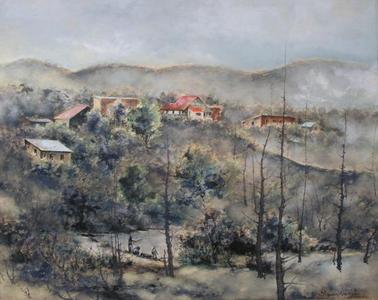Estampe japonaise "View of town in country" par Yoshida Hiroshi
Artiste :Yoshida Hiroshi
Titre :View of town in country
Date :Not set
Détails :Plus d'informations...
Source :Japanese Art Open Database
Parcourir toutes les 17 130 estampes...
Description :
Tuesday, 31 January 2006 Historically Important Hiroshi Honda Watercolor Hawaiian Hawaii Listed Artist Signed and dated Lower Right 1956 Watercolor 24" x 30", very large painting on board. Unframed This is a very historically important artist. Rarely does his work ever appear. Www.askart.com doesn’t even have him listed. Hiroshi Honda was an American Citizen that was put in one of the United States WWII Concentration Camps. This is a fact that the United States Government really doesn’t want any of us to remember. They don’t teach this to us in grammar school. In 1942, 110,000 Japanese Americans living on the West Coast of the United States were relocated to ten internment camps. It took another forty years for the US government to recognize the violations of this population and culture's constitutional rights. Hiroshi Honda was one of a very few artists who captured daily life in these camps in his paintings. Most of his paintings from the Internment Camps hang in the Smithsonian Museum in Washington DC. Recently, the Honolulu Academy of the Arts prepared an Exhibit on Honda’s paintings. The Exhibit was called Reflections of Internment : The Art of Hawaii’s Hiroshi Honda. The exhibit showed how these aesthetically and historically important paintings recorded the despair, isolation, and boredom of daily camp life. And how his work also serves to remind us that we must constantly and consistently safeguard the rights of our citizens in order to assure freedom and equal justice for all. Ever since I purchased this painting I have been afraid to list it for sale. I having been buying and selling art for over 10 years. The values of most artists paintings are easy to gage as values are based on past auction results and the art markets interest in that subject and maybe the painting is of a famous place or was on the cover of a magazine. However, paintings from this artist never come up and the historical importance of this painting is huge, it tells us a story about a culture of people at a certain period of time. So, I have been scared to sell it because I am afraid that I am going to undervalue the piece and sell it cheap to only find out later it was worth a fortune. This is a fabulous painting depicting life in a Japanese Immigrants Village somewhere in California in the 1950’s. There are three people fishing at a small pond below a small village. There are seven small homes or shacks. Asian America Immigrants where not allowed to buy Land in California because of Legislation called the California Alien Land Law that was passed in 1913. Asian Immigrants where only allowed to lease land in 3 year terms. So the Japanese Immigrants although many were U.S. citizens lived in small villages such as what this painting is showing us. They were not afforded the rights to invest in property and build nice homes. So they lived in small shacks in small shanty town like villages. It was not until 1948 in the legal case Oyama v. California, the Supreme Court struck down the Alien Land Laws as violations of the Fourteenth Amendment and Japanese Americans were allowed to purchase land. This painting is dated 1956. The paintings in the Smithsonian by Hiroshi Honda reflect the life of the Japanese Americans living in United States Internment Camps from 1942-1945. This painting reflects another day in the life of that culture, but after their Internment. This painting should be in the Smithsonian in that collection to add to that timeline of earlier paintings. It expresses the life of the Japanese Immigrants more than a decade after their release from the Internment Camps. You would have thought their quality of life would have been better. But this artist paints a different story. White Caucasian Americans had a very good quality of life after World War II. Jobs were plentiful, even entry level positions supplied enough income for almost all to afford to buy a home and live the American dream. This painting shows the meek life the Japanese/Americans were living 11 years after WWII. The painting gives off a somber feeling. The day looks overcast and the trees have lost their leaves. The feeling it gives me reaches out to those people who lived in those shacks. The artist certainly knew how to express more than just the scenery. You actually feel something when you know the history of these people and then look at this painting. The painting talks to you. It shows you what kind of life the Japanese/Americans were living in 1956. That is why this is such a historically important painting, it is so much more than a normal painting by a listed artist. It is a painting of a way of life of a culture of people who were denied their rights as citizens by the United States Government. There are not that many paintings like is. When you have read this paragraph and look at this painting you begin to understand what Art people mean when they say “the painting tells a story”. It took me a long time to grasp that concept. But, this painting silently speaks volumes. It truly is a Masterpiece of American History. With that said I know I undervalued this painting.
